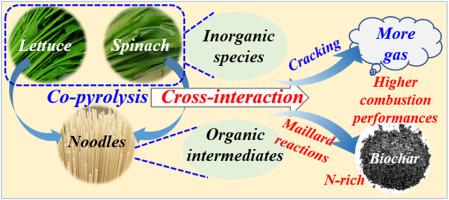Co-pyrolysis of starch-rich food with ash-rich vegetables: Importance of inorganics in shaping pyrolysis reaction network and kinetics
IF 5.8
2区 生物学
Q1 AGRICULTURAL ENGINEERING
引用次数: 0
Abstract
Vegetables tend to have higher content of inorganics and might involve in co-pyrolysis and impact characteristics of pyrolytic products. This was investigated by co-pyrolysis of lettuce or spinach with noodles at 600 °C. The results showed that the inorganics and/or the volatiles from lettuce/spinach interacted with noodles-derived organics, enhancing gasification, which produced more gases while diminished biochar formation. The inorganics in lettuce or spinach also catalyzed cracking of themselves to form more organics with π-conjugated structure in bio-oil. Moreover, the activation energy (Ea) in the pyrolysis of noodles or nascent biochar of higher aromatic nature was much higher than that in pyrolysis of spinach or lettuce. However, exposure of more inorganics from vegetable-derived biochar, at only high feedstock conversion (>20 %), significantly involved in the pyrolysis, reducing Ea in the co-pyrolysis. The co-pyrolysis enhanced combustion performances and also densification of biochar structures with lowered environmental impacts.

富含淀粉的食物与富含灰分的蔬菜共同热解:无机物对形成热解反应网络和动力学的重要性
蔬菜的无机物含量较高,可能会参与共热解并影响热解产物的特性。我们在 600 °C 下对莴苣或菠菜与面条的共热解进行了研究。结果表明,莴苣/菠菜中的无机物和/或挥发性物质与面条中的有机物相互作用,促进了气化,产生了更多气体,同时减少了生物炭的形成。莴苣或菠菜中的无机物还能催化自身裂解,在生物油中形成更多具有π-共轭结构的有机物。此外,热解面条或芳香性质较高的新生生物炭时的活化能(Ea)远高于热解菠菜或莴苣时的活化能(Ea)。然而,在原料转化率较高(20%)的情况下,蔬菜生物炭中更多的无机物会显著参与热解,从而降低共热解的 Ea。共热解提高了生物炭的燃烧性能和致密化程度,降低了对环境的影响。
本文章由计算机程序翻译,如有差异,请以英文原文为准。
求助全文
约1分钟内获得全文
求助全文
来源期刊

Biomass & Bioenergy
工程技术-能源与燃料
CiteScore
11.50
自引率
3.30%
发文量
258
审稿时长
60 days
期刊介绍:
Biomass & Bioenergy is an international journal publishing original research papers and short communications, review articles and case studies on biological resources, chemical and biological processes, and biomass products for new renewable sources of energy and materials.
The scope of the journal extends to the environmental, management and economic aspects of biomass and bioenergy.
Key areas covered by the journal:
• Biomass: sources, energy crop production processes, genetic improvements, composition. Please note that research on these biomass subjects must be linked directly to bioenergy generation.
• Biological Residues: residues/rests from agricultural production, forestry and plantations (palm, sugar etc), processing industries, and municipal sources (MSW). Papers on the use of biomass residues through innovative processes/technological novelty and/or consideration of feedstock/system sustainability (or unsustainability) are welcomed. However waste treatment processes and pollution control or mitigation which are only tangentially related to bioenergy are not in the scope of the journal, as they are more suited to publications in the environmental arena. Papers that describe conventional waste streams (ie well described in existing literature) that do not empirically address ''new'' added value from the process are not suitable for submission to the journal.
• Bioenergy Processes: fermentations, thermochemical conversions, liquid and gaseous fuels, and petrochemical substitutes
• Bioenergy Utilization: direct combustion, gasification, electricity production, chemical processes, and by-product remediation
• Biomass and the Environment: carbon cycle, the net energy efficiency of bioenergy systems, assessment of sustainability, and biodiversity issues.
 求助内容:
求助内容: 应助结果提醒方式:
应助结果提醒方式:


